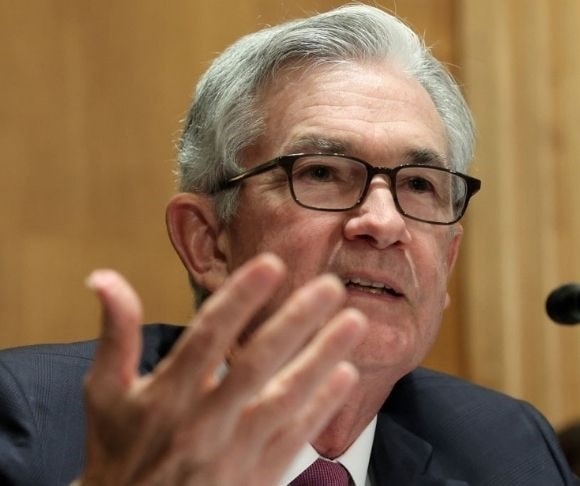The private sector is ringing the alarm bells, telling shoppers that they should be prepared for higher prices for longer. The data point to a prolonged inflationary period. Even the White House is now anticipating a rising consumer price index (CPI) heading into 2022 and members of the Federal Reserve system are concerned that inflation could metastasize into a permanent fixture of the U.S. economy a lot longer than the central bank had initially forecast. And yet, Fed Chair Jerome Powell is in a stage of denial, assuring everyone that red-hot inflation is still transitory. Is Powell a stable genius or too afraid to admit he was wrong?
Jerome Powell’s Virtual Reality

Jerome Powell
(Photo by Win McNamee/Getty Images)
The U.S. central bank recently hosted its Jackson Hole summit virtually. This is an annual Fed retreat that essentially serves as a powwow of the power brokers and what they view as factors and threats to economic growth, monetary policy, the labor market, and anything else that falls within their congressionally approved mandates. Powell delivered his much-anticipated prepared remarks, and financial markets were ostensibly pleased because the Fed did not throw an unexpected breaking ball. Instead, the speech was a meatball right over the plate that allowed investors to go bridge during the Aug. 27 trading session.
Powell confirmed that the Fed would begin a tapering campaign of its pandemic-era ultra-aggressive quantitative easing (QE) program by the end of the year. However, it is unclear as to how much the Federal Open Market Committee (FOMC) members will agree to unwind the $120-billion-a-month monthly bond and mortgage-backed securities (MBS) purchases. The United States will seemingly find out during next month’s popcorn-inducing policy meeting.
Interest rates are likely to remain near zero because, according to Powell, the recovery has “much ground to cover” before the economy hits maximum employment.
“The timing and pace of the coming reduction in asset purchases will not be intended to carry a direct signal regarding the timing of interest rate liftoff, for which we have articulated a different and substantially more stringent test,” Powell explained in a speech for the yearly symposium in Wyoming.
Despite inflation now being upgraded to a “cause for concern,” Powell doubled down on his supposition that it is transitory. But rather than have a knee-jerk reaction to a surging CPI or personal consumption expenditures (PCE) price index, the Fed head is adopting a wait-and-see approach, noting that “time will tell whether we have reached 2% on a sustainable basis.” Perhaps it is a conspiracy theory, but it makes sense as to why the Eccles Building ditched a decades-old policy. Last summer, the Fed altered a conventional response mechanism that would prompt officials to pull the trigger on a rate hike when inflation rises – installing in its place an averaging system. However, not everyone concurs that inflation is benign.
A Jerome Powell Intervention?
Not everyone at the central bank is convinced inflation will melt away like an ice cream cone on a hot summer’s day. Business leaders are also urging the Fed to be more cautious about being so cavalier regarding inflation.
 Patrick Harker, the president of the Philadelphia Fed Bank, told CNBC that the diverse array of price pressures does not appear to be fading. “There’s also some evidence that they may not be so transitory, and that’s a risk I’m worried about,” he averred, adding that companies in his region are also “seeing clear price pressures” and “they are passing some of that along.”
Patrick Harker, the president of the Philadelphia Fed Bank, told CNBC that the diverse array of price pressures does not appear to be fading. “There’s also some evidence that they may not be so transitory, and that’s a risk I’m worried about,” he averred, adding that companies in his region are also “seeing clear price pressures” and “they are passing some of that along.”
“So far people have been understanding,” Harker purported, “That won’t last forever. At some point, we need to get this under control.”
Atlanta Fed President Raphael Bostic said in an interview with the business news network that the institution must make sure “we’re on this” because “runaway inflation is really going to hurt people at the bottom of the ladder.” Despite employee compensation going up, the gains in wages and benefits are being canceled out by a skyrocketing cost of living.
Moreover, even taking out the Austrian analysis of the printing press on prices, the many trends forming in the broader economy suggest the CPI, the PCE price index, and the producer price index (PPI) will remain high for many more months or years to come. For example, Liberty Nation recently reported that freight rates are climbing, shipping containers are going through a shortage, and congestion levels are the highest in years. As a result, some firms are going as far as urging customers to prepare for their Christmas shopping now because of capacity issues that will linger over the next 12 months.
Will Bidenflation Make Conditions Worse?
President Joe Biden and the Democrats have shown zero restraint when it comes to being fiscally responsible. From the $2 trillion spending bill earlier this year to the latest $3.5 trillion infrastructure push, the leaders in Washington contend that spending more will eliminate the inflation threat. This is mental gymnastics foisted upon the American people, highlighting why the citizenry feels so disgusted by the men and women in the nation’s capital. It defies common sense and insults the public’s intelligence. The more cash being approved and consumed, the more money will need to be taxed, borrowed, and printed to ensure the halls of Congress stay open. When modern monetary theory (MMT) is popular among progressives, it is easy to surmise where this Frankenstein economics evolved from in the first place.
~
Read more from Andrew Moran.




